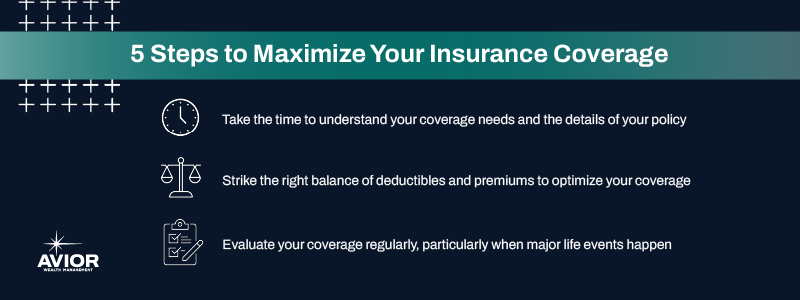5 Steps to Maximize Your Insurance Coverage
Insurance planning is a key part of your financial plan.

Insurance coverage is not only crucial to ward off life’s unexpected mishaps, but it’s also a necessary safety net for your financial plan. It sets up a cushion for you and your family and protects you from the great unknown. In addition, insurance can also provide some predictability to your wealth management, as well as diversify your portfolio, mitigate risk, and lower your potential tax burden.
Just as a solid financial plan takes time to develop, the same goes for solid insurance coverage. It touches on the same considerations, such as goals, concerns, income, and investments. Below we explore why insurance is an essential planning consideration and how to maximize your coverage.
Understand your coverage needs
There are many varieties of insurance coverage, all of which are worth considering as part of your portfolio.
- Life insurance: If you have a partner or dependents who rely on you financially, then life insurance is a must. In fact, 44% of U.S. households would find themselves in financial hardship if the primary wage earner passed away, 28% within a month. There are two main kinds of life insurance. Term life insurance locks in rates over a certain period of time, which can be helpful for covering a particular financial goal, including paying off debt or college tuition. Permanent life insurance covers you for life, which costs more but is useful to supplement retirement savings or provide a death benefit for a spouse or dependent.
- Health insurance: No matter how healthy you are, unforeseen medical bills are always a possibility, starting at $30,000 for a three-day hospital stay. Health insurance often comes from an employer or the federal health insurance marketplace during open enrollment periods. There are many ways to mitigate high premiums, including high deductible health plans or health savings accounts (HSAs).
- Disability insurance: A common misconception is that disability insurance is only for people whose jobs require dangerous work. Actually, the majority of disabilities – cancer, diabetes, arthritis, back pain – don’t happen because of work. So, disability insurance is really for everyone. It replaces up to 70% of your income if you have to stop working due to a disability or illness. It typically comes from workplace group disability insurance or individual policies.
- Long-term care insurance: There’s a 70% chance that adults 65 or older will need long-term care at some point, be it in-home assistance or a stay at a nursing facility. These services and facilities are notoriously expensive, so long-term care insurance can make all the difference in living comfortably in later years. The cost of this coverage can go up as you age, so it’s recommended to purchase it in your 50s or 60s. Many life insurance policies include it or have the option to add it as a rider.
- Property and casualty insurance: This is an umbrella term that includes such policies as auto, renters, homeowners, and condo insurance. Property coverage includes personal property such as a house, furniture, a car, clothes, or valuables. Casualty coverage protects you against liability if someone is injured on your property or in a car accident.
There are a few key factors to consider when determining your insurance needs. These include:
- Stage of life: Age can have a big impact on auto insurance premiums, especially if you’re over 75 or under 25. Age also affects life insurance premiums – younger policyholders tend to pay less because they are healthier and will live longer.
- Health: Most providers require medical exams to determine weight, height, cholesterol, and blood pressure, among other factors.
Financial pressures and outside risk factors are also important considerations. Other life circumstances, such as home ownership, marital status, self-employment, and whether you have kids, all help determine how much insurance you need.
Evaluate your existing policies
Picking the right policies is only the beginning. It’s just as important to review them regularly to make sure they continue to meet your needs. Sit down with them at least once a year to make sure that your family and possessions have adequate protection.
It’s also a good idea to reevaluate your level of coverage after a major purchase or life event, such as buying a house, getting married, receiving an inheritance, or getting the kids to college. An annual review can lower your costs if you qualify for new discounts or require less coverage than in previous years.
An annual review is also helpful to point out common gaps in coverage that can be easy to overlook. These may include:
- Personal catastrophe liability coverage: Protects you from personal injury or liability lawsuits in the event of an accident.
- Flood insurance: If you live in a high-risk flood area, it’s worth considering adding this coverage. Many private insurers don’t include it, but it is available from the National Flood Insurance Program.
- Coverage for valuables: Any artwork, electronics, or expensive jewelry may not be covered under your homeowners’ policy. Consider getting a scheduled personal property endorsement to be properly reimbursed if your valuables are damaged or stolen.
- Updated homeowners’ insurance: If you’ve done any recent home renovations, it pays to let your insurance agent know. Otherwise, you may find yourself out of pocket if you have to rebuild. Replace your roof and you may even lower your premiums.
As you can see, there are many reasons it pays to keep your existing policies up to date.
Optimize your insurance coverage
It’s important to make sure your coverage works hard for you, and that means managing your deductibles and policy limits strategically. Your deductible is the amount you pay out of pocket before your insurance takes effect. Deductibles typically range from $100 to $1,000 and apply to certain coverages like collision and comprehensive.
A policy limit is the total amount your insurance will pay for a claim under your policy. A typical policy limit has an amount that is covered per person and another that represents the total covered.
One strategy to keep monthly premiums low is to have a high deductible and a lower policy limit. This can be tricky if you find yourself unable to pay the higher deductible on top of any accident-related expenses. Consider your risk tolerance versus what you can afford.
Another way to optimize your coverage is to make use of riders, which are provisions that amend the policy terms or add benefits. They can come with a minimum additional cost and supplement home, auto, life, or rental insurance. Some additional coverage makes sense, such as an earthquake rider for policyholders in the San Francisco area. But those same policyholders wouldn’t need flood insurance nearly as much as those living in New Orleans.
Understand your policy terms and conditions
No matter your type of policy, read your official general policy documents so you have a basic understanding of the terms and conditions.
- Declarations page: This should be your first stop when reading these documents. It provides a rundown of the policy and what it covers. It has the basic details you’ll need in a pinch – policy number, type of coverage, period of coverage, premiums, deductibles, and limits.
- Insuring agreement: This digs further into the details of what’s covered in your policy.
- Exclusions: It’s just as important to know what your policy does not cover, as well as what it does. Policies may have multiple exclusions as well as exceptions to those exclusions.
- Terminology: There may be unfamiliar words and phrases in your policy documents. Every policy should have a glossary. Make good use of it so that you stay informed as you read through the policy.
- The fine print: Insurance documents can be dense and may take time to read and comprehend. But they give you a deeper understanding of what’s available to you.
When choosing a policy, have a professional help sort through all your options. If your insurance needs are more complex, a broker can be a useful mediator between you and the insurer, helping you find the best policy for your budget. Consider a broker if you have multiple homes or vehicles, have substantial business interests, or simply want a more efficient way to shop around to multiple insurers.
Plan for the future
Life changes sometimes require insurance changes. You may need to add or change coverage depending on new circumstances. Here are some of the most common examples:
- Getting married: When you commit to sharing your life with another person, you also commit to sharing your financial life. If one of you passes away, what financial responsibilities would pass on to the other partner? Life insurance can provide for a spouse if their standard of living were to be threatened by an unexpected event.
- Starting a family: When families first have children or otherwise grow their family, it’s not uncommon to take on a life insurance policy or add additional coverage to existing policies. In the event a parent passes away, this can help mitigate any financial pressure that might befall the rest of the family.
- Purchasing a home: This is, of course, a major financial purchase, and homeowners’ insurance now comes into play. But life insurance can also be useful to help cover the mortgage in the event the family breadwinner is no longer alive.
- Starting a new job: Most employers offer health and life insurance coverage. It may be different from your previous employer, so it’s important to evaluate whether you need to purchase additional coverage.
As mentioned earlier, regular reviews of your coverage are essential to ensure that it still provides you and your family with the protections you need when major life events occur.
Let the pros help you maximize your coverage
At first glance, insurance can seem like an overwhelming sea of choices, prices, and coverages. But with careful planning and regular assessment, you can make sure your family has the firewall it needs in the event of an unforeseen event.
With over a century of collective wealth management experience, Avior Wealth Management’s team can quarterback your insurance plans, making sure you have a handle on your coverage needs, thoroughly understand your policy, and make time to regularly reevaluate how it’s working for you. Get started today and reach out to one of our team members.
Disclaimer: Nothing contained herein should be construed as legal or tax advice. Avior and our Advisors will work with your attorney and/or tax professional to assist with your legal and tax strategies. Please consult your attorney or tax professional with specific legal and/or tax questions.
No Comments
Sorry, the comment form is closed at this time.




